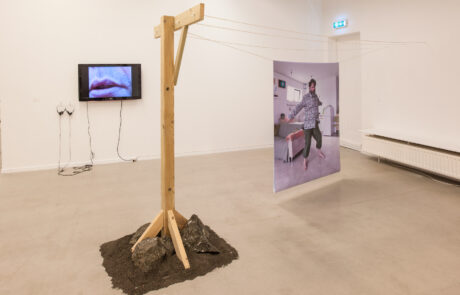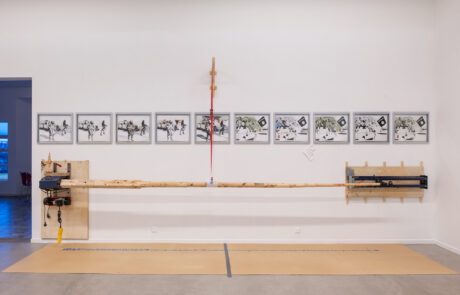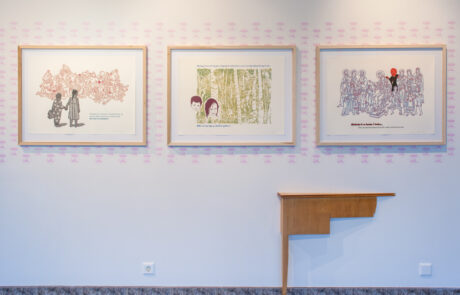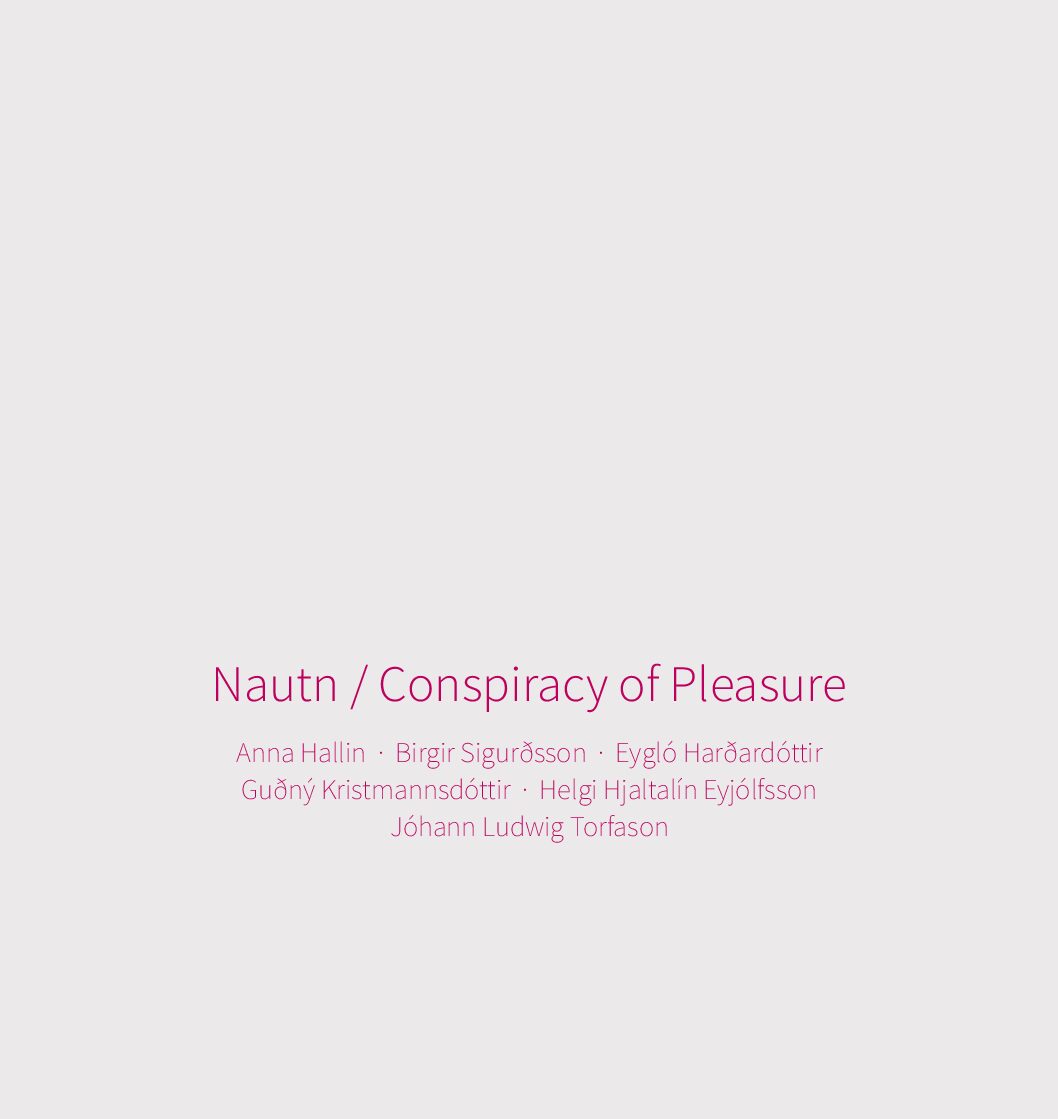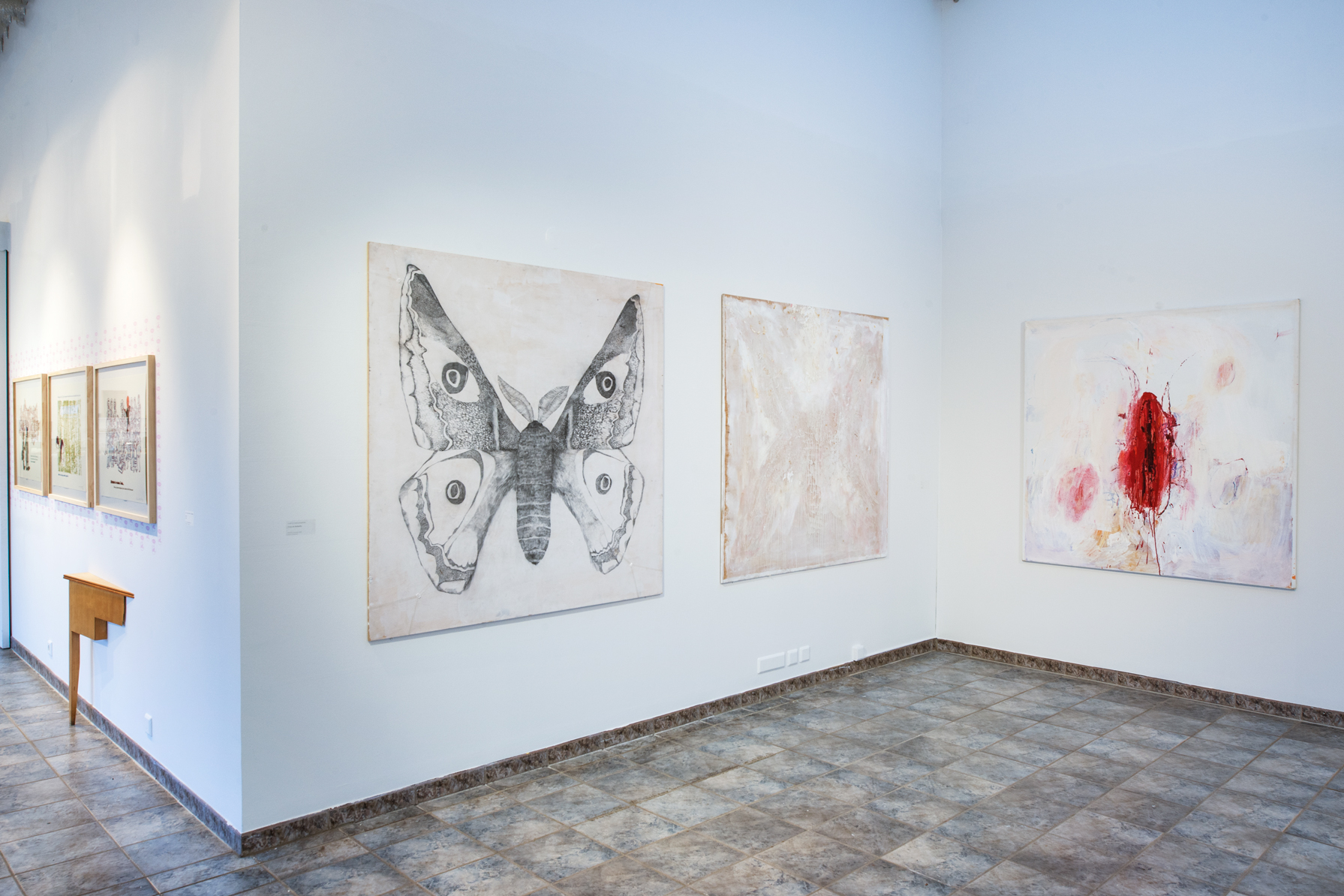
Conspiracy of Pleasure
26. nóvember 2016 – 26. mars 2017
Markús Þór Andrésson
Independant visual arts professional
According to Sigmund Freud’s theory the human being is more or less controlled by pleasure. When one’s physical, spiritual and sexual urges are met, we are executing what the psychoanalyser calls the “pleasure principle“. That addresses the driving force that aims to fulfill all our needs, longings and desires. The lack of satisfying those can lead to anxiety and stress. The urges however, according to the principle, dwell in different hideouts in the brain from those of reasoning, which consider among other things, moral and sociological values, and a constant conflict is ongoing. This kind of mapping our brains always sparks an interest – but so many men, so many minds. Freud’s theories have been hugely criticized but the subject still remains equally haunting.
We are constantly trying to restrain ourselves, since it seems to be our nature to go to extremes. Early on we get acquainted with the dos and don’ts of social norms. Laws and regulations prevent us from abusing our fellow man when satisfying our pleasures, and religions set moral boundaries. Though misleading, the messages are all-encompassing and individuals and societies will undoubtedly never agree on clear borders in these matters. Various things, however, will confirm that repression possibly leads to some kind of outburst – possibly on a very different front. When one’s needs are not met in one area, it will lead to excessive consumption in another area.
The history of pleasure is also the history of the consumer society which is run on an updated version of the pleasure principle. All around us is an overload of stimulus, an ocean of information and pictures that speak to us and tempt us, on the streets and inside our homes. Our everyday lives are filled with simple solutions, aiming to meet our various needs. Even so, one suspects that the needs were designed long before, in order to sell the solutions. Guilt is the bonus; guilty pleasures. The old basic needs that Freud refers to in his research have changed through the handling of our times, where new needs are unceasingly being invented. Pleasure is bought and sold within some sort of economy where we reward ourselves for everything and nothing. The pleasure process is, so to speak, at a different tempo today than a hundred years ago. Nowadays it is valid to enjoy a thing as soon as the desire for it arises; instant pleasure.
Therefore the question on what is natural, normal and explicitly vital for human beings and what is fiction, false and frivolous, becomes ever more obtrusive. The subject has been in everyone’s books all the way since Freud formulated it so long ago, and a lot has been written, especially on the growing compliance to unwanted desires in everyday life. In the latter part of the last century we were “learning from Las Vegas”1 and indeed the modern man’s cityscape had become a “variation on a theme park”2. Simultaneously we were “amusing ourselves to death”3 in a “society of the spectacle”4. Now, in the 21st century, things look different whereas human existence has, to a large extent, become digital. That applies especially to longings and desires, which are the binding agent for the world wide web. Theorists and philosophers now present ideas on “how we became posthuman”5 when a “rendezvous of the body and technology”6 was upon us. Does digital reality serve us as an outlet for unrestrained longings, or only to provoke them and in the end demand a real implementation?
The starting point for this exhibition took place in communication between the artists on precisely these complex and most often amusing interests. Where do the boundaries lie between normal and humane nurturing of pleasures and joys, on the one hand, and submitting to them without restraint, on the other hand? When does anything become a fetish? What is the difference between sensuality and excessiveness, eroticism and pornography, beauty and kitsch, desire and addiction, ambition and greed, lofty goals and nonsense? Who has the power to put forth these definitions? The distinction depends on standards, era, societies and groups. As an example, standards for men and women vary. Boundaries that individuals set for themselves may be variably flexible. And we are all shocked as soon as we witness somebody enjoying beyond what is considered normal. Or do we send the sensualist in question into rehab?
Out of a conversation between a few artists, the idea to put together an exhibition that would reflect these speculations was born. Planning took place over the course of a good year, where various things came up regarding pleasure, desire, urges and cravings. Different manifestations of these traits were the main subject as well as what role they play in art creation. Does the creation of an art piece cater to deep and unrestrained urges of the artist’s subconscious? Or does he/she manage to tame the process through reasoning and trained working methods? At the exhibition, we can see new works from six artists who collaborate in posing questions on pleasure, each from their own perspective and on their own terms.
The abstract works of Eygló Harðardóttir do not make claims to a certain subject in themselves, and even less to a value-charged concept such as pleasure. The characteristics of the works are not visualisation of ideas; but the yield of a struggle with material and method. In the work process definitions and reasoning are abandoned. Simple solutions and effectiveness are ignored since those only trigger a moment long fascination? The challenge is in capturing something deeper; in dwelling with the material and trying something new. Not clinging to the given goals, rather stay alert and spot whatever one might come upon by coincidence during the process. Examine the reverse, the discards, the unsightly. The works demand something, they fret and insist on the process until they have emerged. At this point, it is as if everything eases and the process dies down. The pleasure is in the force that drives this complicated process.
Distinguishing whether Eygló’s works are created with intention or spontaneously is difficult. As an artist she is aware that what she has in her hands each time will potentially become an art piece. Therefore the pleasure of the moment, in the middle of the creative process, blends in with the anticipation of a finished art piece. For the works she created especially for the exhibition she mostly used Japanese paper, plaster and neon color. Numerous other elements were involved, ideas such as expansion and compression, reverse and right side, to take apart and assemble again. In Eygló’s case the pleasure is found in the grounds of the new and unknown, stripped of before-known conveniences, to challenge herself and then reap something significant.
Anna Hallin has a similar attitude. Her focus is on the work process and the pleasure she gets from that. She describes it as entering a territory where she is in full control. External stimulus, daily rounds or life’s flings do not have access to that territory. Not that she knows beforehand what can happen there but it is on her terms and within a frame, ruled by her own principles. Her confidence in this situation is based on her years of experience working with the art mediums she has chosen. In this exhibition it is ink and clay, both materials where small mistakes can result in everything going down the drain. The pleasure lies in knowing her abilities but constantly searching for ways to challenge herself and go further.
Anna’s works are physical and inspired by sculpture-history’s timeless torsos. Yet they are far from being figurative, on the contrary they’re dissymmetrical, but the forms are curved and organic. The presence of the body is especially evident in how the form of the ceramic pieces seem to call for contact and intimacy. The complex texture is either matte, coarse, polished or shiny, which produces a tickling sensation in one’s fingertips. One can sense the metamorphosis of the material in the burner, see how the glaze melts and then hardens in the middle of the process. The drawings stagger, like the clay pieces, on the verge of the manoeuvrable and the spontaneous. A strict line picks up spatter and smudge. Anna is fond of the pleasure that sprouts from first hand crafts where thought and act are right on target and free of external disturbance. Some kind of mindful art creation.
Birgir Sigurðsson examines the concept of pleasure at the borders of opposites such as the physical and the subjective, the positive and the negative. Wherever the pleasures are situated on such a spectrum, they demand attention in the everyday life and insist on being tended to. This is not the first time the artist sets forth autobiographical work based, among other things, on food addiction. By studying his own experience especially, he poses forthcoming and haunting questions on the nature of what is commonly thought of as excess. With his work in this exhibition he continues to ponder on control and chaos, as well as some sort of cleansing process or atonement. Birgir has chosen cuisine and dance as an example of something that gives him special joy. He exhibits a performance and an installation based on these topics. He has also printed photographs on fabric, which he has hung like laundry on a clothesline.
Contemplations on the before mentioned blurred borderlines, are evident in the works of Helgi Hjaltalín Eyjólfsson. The borderlines of society’s tolerance and those deviations that the individual perhaps desires and/or allows himself. The artist frequently presents tools or situations where a particular project is meant to be executed. Here, Helgi presents a humorous installation which could be described as the worktable of a sign-maker who has never heard of political correctness. Prejudgements and prejudice get to prosper undisturbed, and outdated slogans are dressed in capitalism’s charming attire. Another installation shows a flagpole in a specially made lathe, designed for shaping flagpoles. Alongside are ten watercolor pictures of members of the organization named after the Islamic State, ISIS. The pictures show heavily armed units getting on with their daily work. Two different picture topics, most likely from news reels or the internet, are painted repeatedly five times each, although none is finished.
Helgi’s works remind us of the marked-driven society we live in. Success is measured by meeting certain requirements, both in corporate and private life. By presenting in his works weird, closed processes that appear to be conditioned to serve only one, defined purpose, Helgi doubts the possibility to pause and assess the path one could be following. When everyone’s eyes are on reach- ing a goal they tend to forget the question on the process’s real value.
Like Helgi, Jóhann Ludwig Torfason presents a system and a process, but in the form of a pictorial test. He shows different games that resemble board games or rebuses. When taking a closer look, a more dubious message lies behind, out of tune with what is commonly accepted. Sexual fantasies, prejudice and addiction are presented in an innocent manner, but in the form of a contest or a result-driven game. The work’s aesthetics use post-war imagery; when a certain innocence and playfulness characterized all marketing. Thereby we are reminded of the fact that values and standards regarding moral issues often depend on the Zeitgeist. Some issues that are repressed during one period can later be accepted, or a negative picture drawn up of something that was customary before.
Jóhann’s art creation is presented under the synonym of an imaginary workshop which he calls Daddy’s knee. It first came into play in 2005, as some kind of a caption or company that gave artists a chance to present work under someone else’s name than their own. Although the secrecy is just a game, and who is actually behind the works is clear to everyone, this alter ego opens up the possibility for a different type of expression. At the same time, the arrangement reflects how easy it is for an individual in a capitalistic society to elude personal responsibility. Pleasures thrive under the protection of the market economy, not to mention greed, that otherwise would have fewer outlets.
Sexual and physical pleasure play a role in Jóhann’s well-balanced and stylized imagery. Guðný Kristmannsdóttir chooses a more expressive way towards the same subject in her enormous paintings, which she creates with exaggerated brush strokes, a texture of many nuances and colorfulness. She finds her topics in nature and old familiar references to sensuality and eroticism. Rabbits are frequently used in connection with the sex industry, representing vigorous sexual activity. The symmetry of a butterfly has been seen as a symbol for a vulva, especially the King butterfly which swells up with blood, when breaking out of its cocoon, so it may move its wings and live. Guðný exhibits these clichés-like subjects in a personal way, in her works.
She transforms and deforms them and uses in an independent manner. At the same time the sensual and the natural is made exotic, with a reference to the horrible and the manmade, though without any hierarchy or judgement.
Guðný celebrates the pleasure of the fertilization process, whether it be sexual activity of humans or the artist’s joy of creation. She is fascinated by the ideas of the surrealists who rejected predetermined values of the bourgeois society and searched for unrestrained connection to the subconscious where dreams, hopes and longings were released in sheer playfulness. Guðný also utilizes literature and two novels have especially influenced her work in this exhibition; Nabakov’s Lolita and Kafka’s The Metamorphosis.
The conversation between the six artists who participate in this exhibition, Nautn / Conspiracy of Pleasure, opened many doors into and away from this complex concept. The works that are presented each tell their own story, personally and societally. We come to realize that interpretations vary tremendously from one person to the next, and we all find pleasure in different things. When the different subjects are set aside we see a harmony in art creation being one of the things that provide pleasure. Art is so magical that after it brings pleasure to the artist through the creative process it multiplies and provides us, the viewers, with the creative pleasure of interpreting.
Nautn / Conspiracy of Pleasure
The ideas behind this project evolve around pleasure and its many principles and manifestations which the artists address each from their own perspective and criteria. What are the cycles of pleasure and desire? Reality is paved with logical lanes along which the subconscious flows. We want to try to touch the imagination through a multidisciplinary overlap and examine our urges in the topography of our desires.
It is interesting to study our conscious, subconscious and reflexive ways, in our search for pleasure. In the consumer society one can frequently see the ideas of the surrealists in advertising where the subconscious is often used to reach the consumer. Our feelings, pleasures and deep urges are played with and fetishes are even used to appeal to us.
According to Freud we use our subconscious to get acquainted with our own fantasies. Through the subconscious we find ways to experience various urges, while fantasies are the grounds for knowing one’s desires.
The group consists of different individuals and artists who, through this project, want to create a common platform where discourse on the role of desire in art and art creation as well as the outlines and topography of desire, in a broad sense, can take place. Whether it be obsessive manifestations of consumer- ism and sex in our times, the appearance of the flesh in visual art, the human body as a symbolic object, inspiration or simply the primitive pleasure which often accompanies art creation in the struggle with material and texture, perception, color and space but also crazes, obsessions, fixations and repetitions in the creative process. In terms of pleasure, it is also interesting to look at how the artists perceive the different mediums they use.
The aim of this collaboration and exhibition project is to invite the viewer to participate in a discussion that takes place within a certain frame that evolves around ideas and theories on pleasure’s main principles and its role in our lives.
Anna Hallin og Guðný Kristmannsdóttir
Curators:
Hlynur Hallsson and Inga Jónsdótir
About the artists:
Anna Hallin
Anna is born in Sweden in 1965 and has lived in Reykjavík since 2001. Anna holds a master degree in ceramics from the University in Gothenburg and in visual arts from Mills College, Oakland, California. She has participated in several group exhibitions in Iceland and abroad and held solo exhibitions in Iceland, Sweden, Finland and Germany, to name a few. Works by her are owned, among others, by Reykjavik Art Museum, Kópavogur Art Museum, Icelandic Folk and Outsider Art Museum, Reykjanes Art Museum and the National Gallery of Iceland. Anna has for a number of years cooperated with artist Olga Bergmann in art projects. Their collaboration has mostly been about visual art in public spaces and an example of that is their prize rewarded proposal for artwork in the new prison building in Hólmsheiði.
Birgir Sigurðsson
Birgir is mostly a self-taught artist, he received however some guidance from Þorvaldur Þorsteinsson for a while. He has held 17 solo exhibitions and participated in several group projects. Birgir has always allowed himself to create all kinds of artwork; light-sculptures, dance-performances, videos, recitals, postcards and poetry, to name a few. His work is however always based on his personal experience. In 2010 Birgir founded 002 Gallery, in his 63 square meter apartment at Þúfubarð in Hafnarfjörður. There Birgir has organized 30 exhibitions with contemporary Icelandic artists.
Eygló Harðardóttir
Eygló (born 1964) graduated from the Icelandic College of Art and Crafts in 1987 and from AKI – Akademie voor Beeldende Kunst in Enschede in the Netherlands in 1990. In 2005 she completed her B.Ed. from the University of Iceland and in 2014 she received an MA degree in Art Education from the Iceland Academy of Arts. Alongside being a recognized artist Eygló has taught both at the Iceland Academy of Art and the Reykjavik School of Visual Arts intermittently. Eygló has worked and exhibited in Iceland and abroad and works by her are owned by several museums.
Guðný Þórunn Kristmannsdóttir
Guðný (born 1965) completed preliminary art studies at the Comprehensive College in Breiðholt in 1988 and went from there to study at the Icelandic College of Art and Crafts in 1988-1991, where she graduated from the department of painting. Soon after she moved to Akureyri and has been living and working there ever since. Her first solo exhibition, Drawings, was in Galleri Svartfugl in Akureyri 1998. Guðný has both held solo exhibitions and participated in various group exhibitions in Iceland and abroad. She was Akureyri City-artist, 2009-2010.
Helgi Hjaltalín Eyjólfsson
Helgi (born 1968) completed preliminary studies in arts at the Comprehensive College in Breiðholt and studied after that at the Icelandic College of Art and Crafts 1988- 1991, at Kunstakademie Düsseldorf 1991-1992, at AKI in The Netherlands 1992-1994 and at San Francisco Art Institute 1994-1995. He has exhibited his work in Iceland and abroad since graduating and his works can be found in the art collection of National Gallery of Iceland and Reykjavik Art Museum. Helgi ran the exhibition space 20m2 and worked various jobs in relations to art such as being a board member at the Association of Sculptress in Reykjavik and The Living Art Museum, served on exhibi tion committees and done some teaching. Helgi’s works are often skilfully made and appear to have some utility value, but do not. He has also worked with other in mediums such as photography, video and colored.
Jóhann Ludwig Torfason
Jóhann (born 1965) studied lithography at the Icelandic College of Art and Crafts 1985 – 1989 as well as multi-technic at the same college 1989 – 1990. He has held 14 solo exhibitions and participated in group exhibitions and performances in Iceland and abroad. Work by Jóhann are owned by museums in Iceland. He founded the company/project Pabbakné (Daddy’s Knee) in 2005 and has held exhibitions under this title ever since. He is one of the founding members of the cartoon magazine Gips and has regularly published cartoon related material there since 1990. Since 2006 Jóhann has been the overseer of the printing shop and a teacher at the Iceland Academy of Arts.
Here you can download the catalogue in Pdf. format.


